Xylosandrus crassiusculus (Motschulsky) on Cocoa Pods (Theobroma cacao L.): Matter of Bugs and Fungi
Abstract
:Simple Summary
Abstract
1. Introduction
2. Materials and Methods
2.1. Study Site, Sample Collection, and Pest Incidence
2.2. Insect Identification
2.3. Documentation of Symptoms and Gallery Measurements
2.4. Isolation and Identification of Associated Fungi
2.5. Choice Test Assay against Healthy and Mirid Affected Cocoa Pods
3. Results
3.1. Insect Identification
3.2. Pest Incidence and Damaging Symptoms
3.3. Associated Fungi Identification
3.4. Choice Test Assay against Healthy and Mirid Affected Cocoa Pods
4. Discussion
5. Conclusions
Supplementary Materials
Author Contributions
Funding
Institutional Review Board Statement
Informed Consent Statement
Data Availability Statement
Acknowledgments
Conflicts of Interest
References
- Lahive, F.; Hadley, P.; Daymond, A.J. The physiological responses of cacao to the environment and the implications for climate change resilience. A review. Agron. Sustain. Dev. 2019, 39, 5. [Google Scholar] [CrossRef]
- Directorate of Cashewnut and Cocoa Development. Available online: https://dccd.gov.in/Content.aspx?mid=1072&tid=1 (accessed on 12 April 2022).
- Beg, M.S.; Ahmad, S.; Jan, K.; Bashir, K. Status, supply chain and processing of cocoa—A review. Trends Food Sci. Technol. 2017, 66, 108–116. [Google Scholar] [CrossRef]
- Dand, R. International Cocoa Trade, 3rd ed.; Woodhead Publishing: Cambridge, UK, 2011; pp. 1–22. [Google Scholar]
- World Cocoa Foundation Report. Available online: https://www.worldcocoafoundation.org/wp-content/uploads/Cocoa-Market-Update-as-of-4-1-2014.pdf (accessed on 26 April 2021).
- Thube, S.H.; Mahapatro, G.K.; Mohan, C.; Pandian, R.T.P.; Apshara, E.; Jose, C.T. Biology, feeding and oviposition preference of Helopeltis theivora, with notes on the differential distribution of species of the tea mosquito bug species complex across elevations. Anim. Biol. 2019, 70, 67–79. [Google Scholar] [CrossRef]
- Entwistle, P.F. Pests of Cocoa: Tropical Science Series; Longman Group Limited Publishing: London, UK, 1972. [Google Scholar]
- Mariau, D. Integrated Pest Management of Tropical Perennial Crops; Science Publishers: Enfields, NH, USA, 1999; p. 173. [Google Scholar]
- CPCRI. Annual Report; Central Plantation Crops Research Institute: Kasaragod, India, 1993; pp. 82–83. [Google Scholar]
- Padi, B. Prospects for the control of cocoa capsids—Alternatives to chemical control. In Proceedings of the First International Cocoa Pests and Diseases Seminar, Accra, Ghana, 6–10 November 1997; pp. 28–36. [Google Scholar]
- Muhamad, R.; Way, M.J. Relationships between feeding habits and fecundity of Helopeltis theivora (Hemiptera: Miridae) on cocoa. Bull. Entomol. Res. 1995, 85, 519–523. [Google Scholar] [CrossRef]
- Thube, S.H.; Saneera, E.K.; Prathibha, P.S. Pests of Cocoa and their management. Cashew Cocoa J. Spec. Issue Cocoa 2016, 5, 34. [Google Scholar]
- Saunders, J.L. The Xyleborus-Ceratocystis complex of cacao. Cacao 1965, 10, 7–13. [Google Scholar]
- Ranger, C.M.; Reding, M.E.; Schultz, P.B.; Oliver, J.B.; Frank, S.D.; Addesso, K.M.; Chong, J.H.; Sampson, B.; Werle, C.; Gill, S.; et al. Biology, ecology, and management of non-native ambrosia beetles (Coleoptera: Curculionidae: Scolytinae) in ornamental plant nurseries. J. Integr. Pest Manag. 2016, 7, 1–23. [Google Scholar] [CrossRef]
- Vega, F.E.; Infante, F.; Johnson, A.J. The genus Hypothenemus, with emphasis on H. hampei, the coffee berry borer. In Bark Beetles: Biology and Ecology of Native and Invasive Species; Vega, F.E., Hofstetter, R.W., Eds.; Academic Press Elsevier: London, UK, 2015; pp. 427–494. [Google Scholar]
- Smith, S.M.; Beaver, R.A.; Cognato, A.I.; Hulcr, J.; Redford, A.J. Southeast Asian Ambrosia Beetle ID. USDA APHIS Identification Technology Program (ITP) and Michigan State University. Available online: https://idtools.org/id/wbb/sea-ambrosia/ (accessed on 10 March 2022).
- Thube, S.H.; Mohan, C.; Pandian, R.T.P.; Saneera, E.K.; Sannagoudra, H.M.; Hegde, V.; Chowdappa, P. First record of the invasive neotropical ambrosia beetle Euplatypus parallelus (Fabricius, 1801) (Coleoptera: Curculionidae: Platypodinae) infesting arecanut in Karnataka, India. Coleopt. Bull. 2018, 72, 713–717. [Google Scholar] [CrossRef]
- Thube, S.H.; Pandian, T.P.; Bhavishya, A.; Babu, M.; Josephrajkumar, A.; Chaithra, M.; Hegde, V.; Ruzzier, E. Xylosandrus crassiusculus (Motschulsky) (Coleoptera: Curculionidae) and its fungal symbiont Ambrosiella roeperi associated with arecanut kernel decay in Karnataka, India. Insects 2022, 13, 67. [Google Scholar] [CrossRef]
- Sambrook, J.; Russell, D.W. Molecular Cloning: A Laboratory Manual, 3rd ed.; Cold Spring Harbor Laboratory Press: New York, NY, USA, 2001; Volume 1. [Google Scholar]
- Li, Y.; Ruan, Y.Y.; Stanley, E.L.; Skelton, J.; Hulcr, J. Plasticity of mycangia in Xylosandrus ambrosia beetles. Insect Sci. 2019, 26, 732–742. [Google Scholar] [CrossRef]
- Harrington, T.C.; McNew, D.; Chase, M.; Fraedrich, S.W.; Reed, S.E. Ambrosiella roeperi sp. nov. is the mycangial symbiont of the granulate ambrosia beetle, Xylosandrus crassiusculus. Mycologia 2014, 106, 835–845. [Google Scholar] [CrossRef] [PubMed]
- Van der Walt, J.P. The yeast Ambrosiozyma gen. nov. Ascomycetes. Mycopathol. Mycol. Appl. 1972, 46, 305–316. [Google Scholar] [CrossRef]
- White, T.J.; Bruns, T.; Lee, S.; Taylor, J. Amplification and direct sequencing of fungal ribosomal RNA genes for phylogenetics. In PCR Protocols: A Guide to Methods and Applications; Innis, M.A., Gelfand, D.H., Sninsky, J.J., White, T.J., Eds.; Academic Press: New York, NY, USA, 1990; pp. 1–315. [Google Scholar]
- Pandian, R.; Thube, S.H.; Merin, B.; Pratibha, V.H.; Rajkumar, M.; Mhatre, P.H.; Hegde, V. First record of Fusarium falciforme (FSSC 3 + 4) a relevant human pathogen causing root decay of arecanut, Areca catechu L. J. Plant Dis. Prot. 2022, 129, 695–699. [Google Scholar] [CrossRef]
- Kühnholz, S.; Borden, J.H.; Uzunovic, A. Secondary ambrosia beetles in apparently healthy trees: Adaptations, potential causes and suggested research. Integr. Pest Manag. Rev. 2001, 6, 209–219. [Google Scholar] [CrossRef]
- Ranger, C.M.; Reding, M.E.; Addesso, C.; Ginzel, M.; Rassati, D. Semiochemical-mediated host selection by Xylosandrus spp. ambrosia beetles (Coleoptera: Curculionidae) attacking horticultural tree crops: A review of basic and applied science. Can. Entomol. 2021, 153, 103–120. [Google Scholar] [CrossRef]
- Rassati, D.; Contarini, M.; Ranger, C.M.; Cavaletto, G.; Rossini, L.; Speranza, S.; Faccoli, M.; Marini, L. Fungal pathogen and ethanol affect host selection and colonization success in ambrosia beetles. Agric. For. Entomol. 2020, 22, 1–9. [Google Scholar] [CrossRef]
- McPherson, B.A.; Mori, S.R.; Wood, D.L.; Storer, A.J.; Svihra, P.; Maggi Kelly, N.; Standiford, R. Sudden oak death in California: Disease progression in oaks and tanoaks. For. Ecol. Manag. 2005, 213, 71–89. [Google Scholar] [CrossRef]
- McPherson, B.A.; Erbilgin, N.; Wood, D.L.; Svihra, P.; Storer, A.J.; Standiford, R.B. Attraction of ambrosia and bark beetles to coast live oaks infected by Phytophthora ramorum. Agric. For. Entomol. 2008, 10, 315–321. [Google Scholar] [CrossRef]
- Chong, J.; Reid, L.; Williamson, M. Distribution, host plants, and damage of the black twig borer, Xylosandrus compactus (Eichhoff), in South Carolina. J. Agric. Urban Entomol. 2009, 26, 199–208. [Google Scholar] [CrossRef]
- Cavaletto, G.; Faccoli, M.; Ranger, C.M.; Rassati, D. Ambrosia beetle response to ethanol concentration and host tree species. J. Appl. Entomol. 2021, 145, 800–809. [Google Scholar] [CrossRef]
- Browne, F.G. The biology of Malayan Scolytidae and Platypodidae. Malayan Forest Rec. 1961, 22, 1–255. [Google Scholar]
- Carlton, C.; Bayless, V. A case of Cnestus mutilatus (Blandford) (Curculionidae: Scolytinae: Xyleborini) females damaging plastic fuel storage containers in Louisiana, USA. Coleopt. Bull. 2011, 65, 290–291. [Google Scholar] [CrossRef]
- Wood, S.L. The bark and ambrosia beetles of North and Central America (Coleoptera: Scolytidae), a taxonomic monograph. In Great Basin Naturalist Memoirs; Brigham Young University: Provo, UT, USA, 1982; Volume 6, 1359p. [Google Scholar]
- Ranger, C.M.; Reding, M.E.; Persad, A.B.; Herms, D.A. Ability of stress-related volatiles to attract and induce attacks by Xylosandrus germanus and other ambrosia beetles (Coleoptera: Curculionidae, Scolytinae). Agric. For. Entomol. 2010, 12, 177–185. [Google Scholar] [CrossRef]
- Ranger, C.M.; Schultz, P.B.; Frank, S.D.; Chong, J.H.; Michael, E.R. Non-native ambrosia beetles as opportunistic exploiters of living but weakened trees. PLoS ONE 2015, 10, e0131496. [Google Scholar] [CrossRef]
- Qin, X.W.; Lai, J.X.; Tan, L.H.; Hao, C.Y.; Li, F.P.; He, S.Z.; Song, Y.H. Characterization of volatile compounds in Criollo, Forastero, and Trinitario cocoa seeds (Theobroma cacao L.) in China. Int. J. Food Prop. 2017, 20, 2261–2275. [Google Scholar] [CrossRef]
- Hulcr, J.; Stelinski, L.L. The ambrosia symbiosis: From evolutionary ecology to practical management. Annu. Rev. Entomol. 2017, 62, 285–303. [Google Scholar] [CrossRef]
- Davis, T.S. The ecology of yeasts in the bark beetle holobiont: A century of research revisited. Microb. Ecol. 2015, 69, 723–732. [Google Scholar] [CrossRef]
- Adams, A.S.; Six, D.L.; Adams, S.M.; Holben, W.E. In vitro interactions between yeasts and bacteria and the fungal symbionts of the mountain pine beetle (Dendroctonus ponderosae). Microb. Ecol. 2008, 56, 460–466. [Google Scholar] [CrossRef]
- Davis, T.S.; Hofstetter, R.W.; Foster, J.T.; Foote, N.E.; Keim, P. Interactions between the yeast Ogataea pini and filamentous fungi associated with the western pine beetle. Microb. Ecol. 2011, 61, 626–634. [Google Scholar] [CrossRef]
- Dien, B.S.; Kurtzman, C.P.; Saha, B.C.; Bothast, R.J. Screening for L-arabinose fermenting yeasts. Appl. Biochem. Biotechnol. 1996, 57, 233–242. [Google Scholar] [CrossRef]
- Redgwell, R.J.; Hansen, C.E. Isolation and characterisation of cell wall polysaccharides from cocoa (Theobroma cacao L.) beans. Planta 2000, 210, 823–830. [Google Scholar] [CrossRef] [PubMed]
- Cruz, L.F.; Rocio, S.A.; Duran, L.G.; Menocal, O.; Garcia-Avila, C.D.J.; Carrillo, D. Developmental biology of Xyleborus bispinatus (Coleoptera: Curculionidae) reared on an artificial medium and fungal cultivation of symbiotic fungi in the beetle’s galleries. Fungal Ecol. 2018, 35, 116–126. [Google Scholar] [CrossRef]
- Menocal, O.; Cruz, L.F.; Kendra, P.E.; Crane, J.H.; Ploetz, R.C.; Carrillo, D. Rearing Xyleborus volvulus (Coleoptera: Curculionidae) on media containing sawdust from avocado or silkbay, with or without Raffaelea lauricola (Ophiostomatales: Ophiostomataceae). Environ. Entomol. 2017, 46, 1275–1283. [Google Scholar] [CrossRef] [PubMed]
- Inward, D.J.G. Three new species of ambrosia beetles established in the UK illustrate unresolved risks of timber importation. J. Pest. Sci. 2020, 93, 117–126. [Google Scholar] [CrossRef]
- Mayers, C.G.; McNew, D.L.; Harrington, T.C.; Roeper, R.A.; Fraedrich, S.W.; Biedermann, P.H.; Castrillo, L.A.; Reed, S.E. Three genera in the Ceratocystidaceae are the respective symbionts of three independent lineages of ambrosia beetles with large, complex mycangia. Fungal Biol. 2015, 119, 1075–1092. [Google Scholar] [CrossRef]
- Guzmán-Alvarez, R.E.; Márquez-Ramos, J.G. Fermentation of cocoa beans. In Fermentation-Processes, Benefits and Risks; IntechOpen: London, UK, 2021. [Google Scholar] [CrossRef]

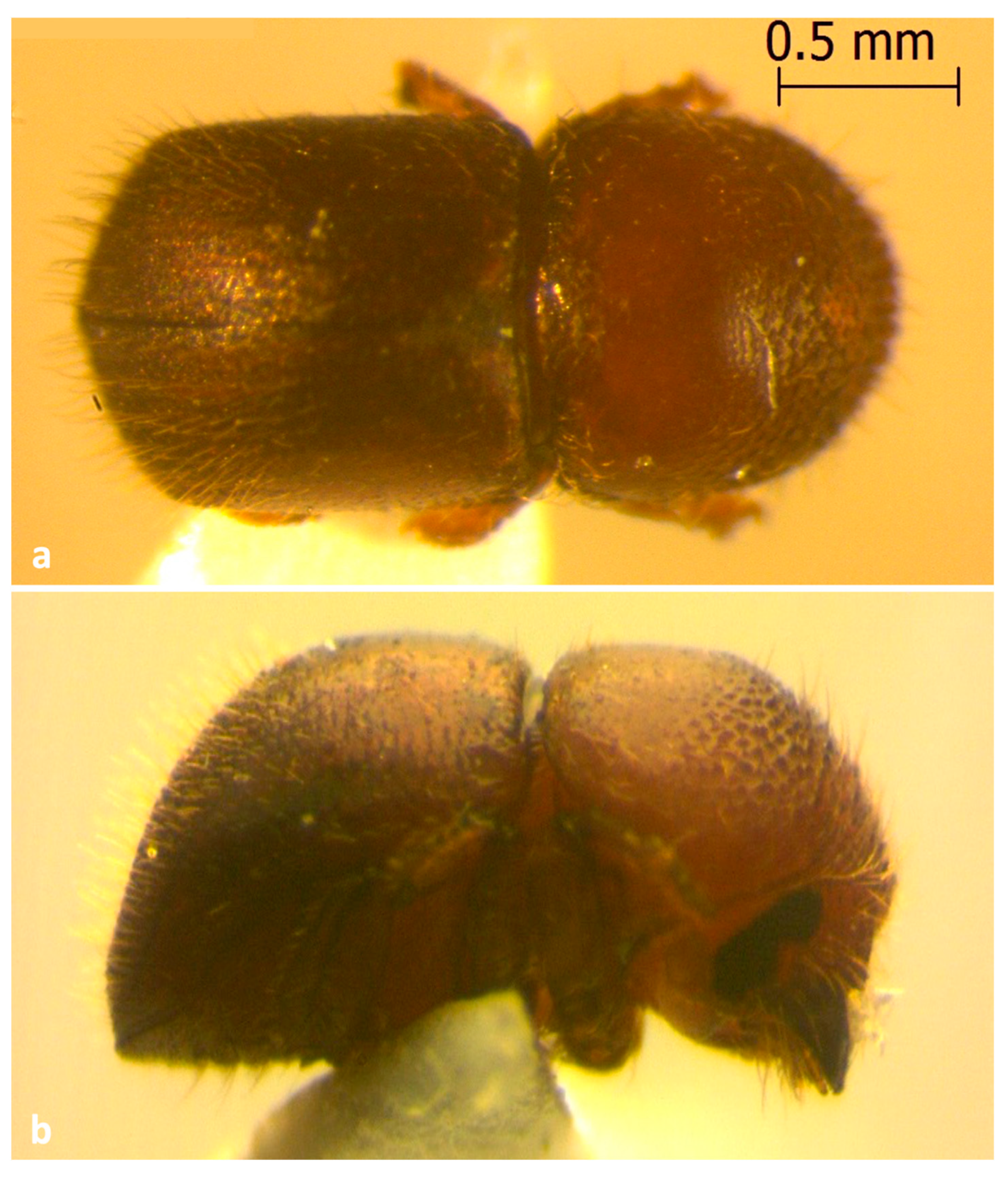

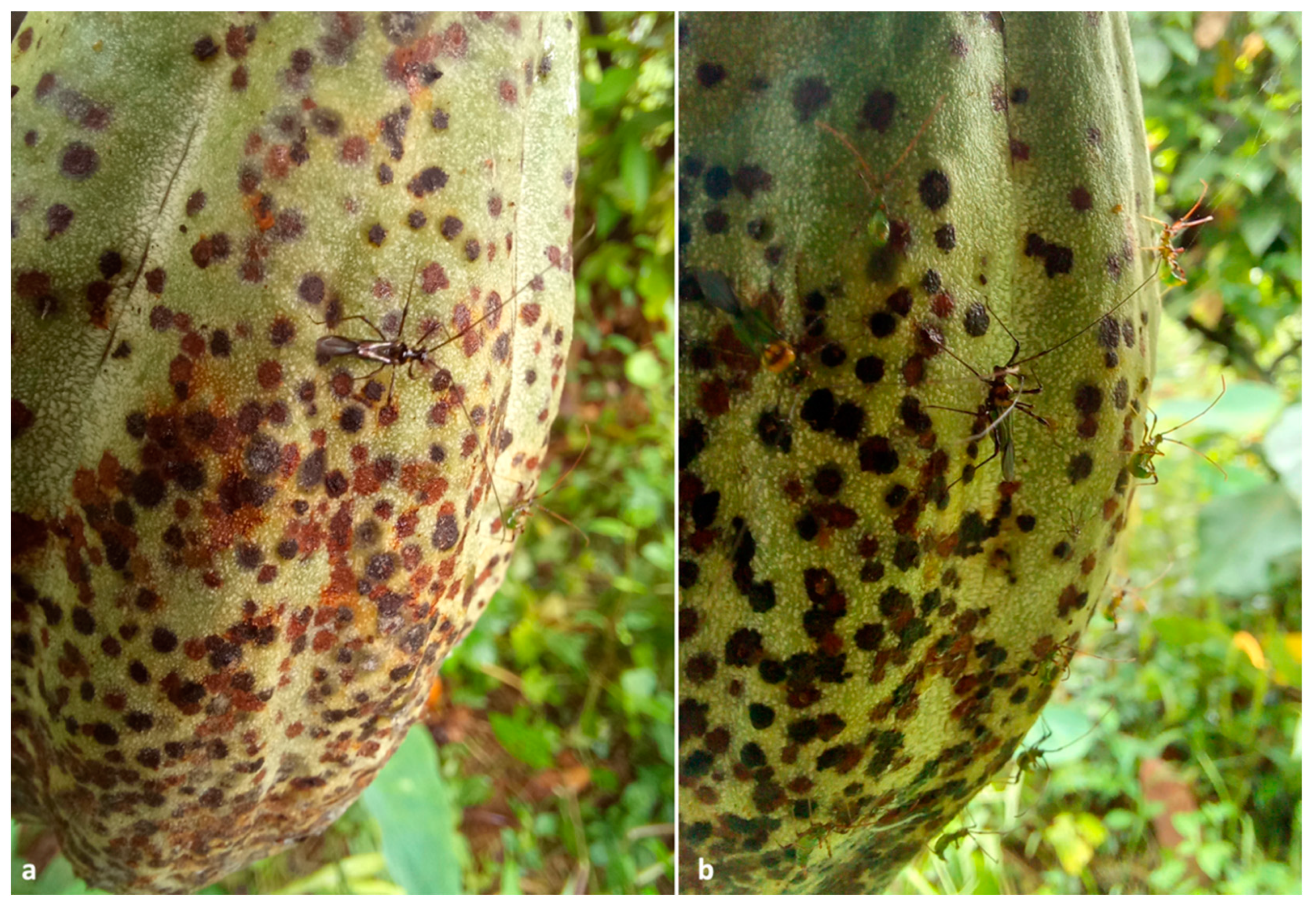
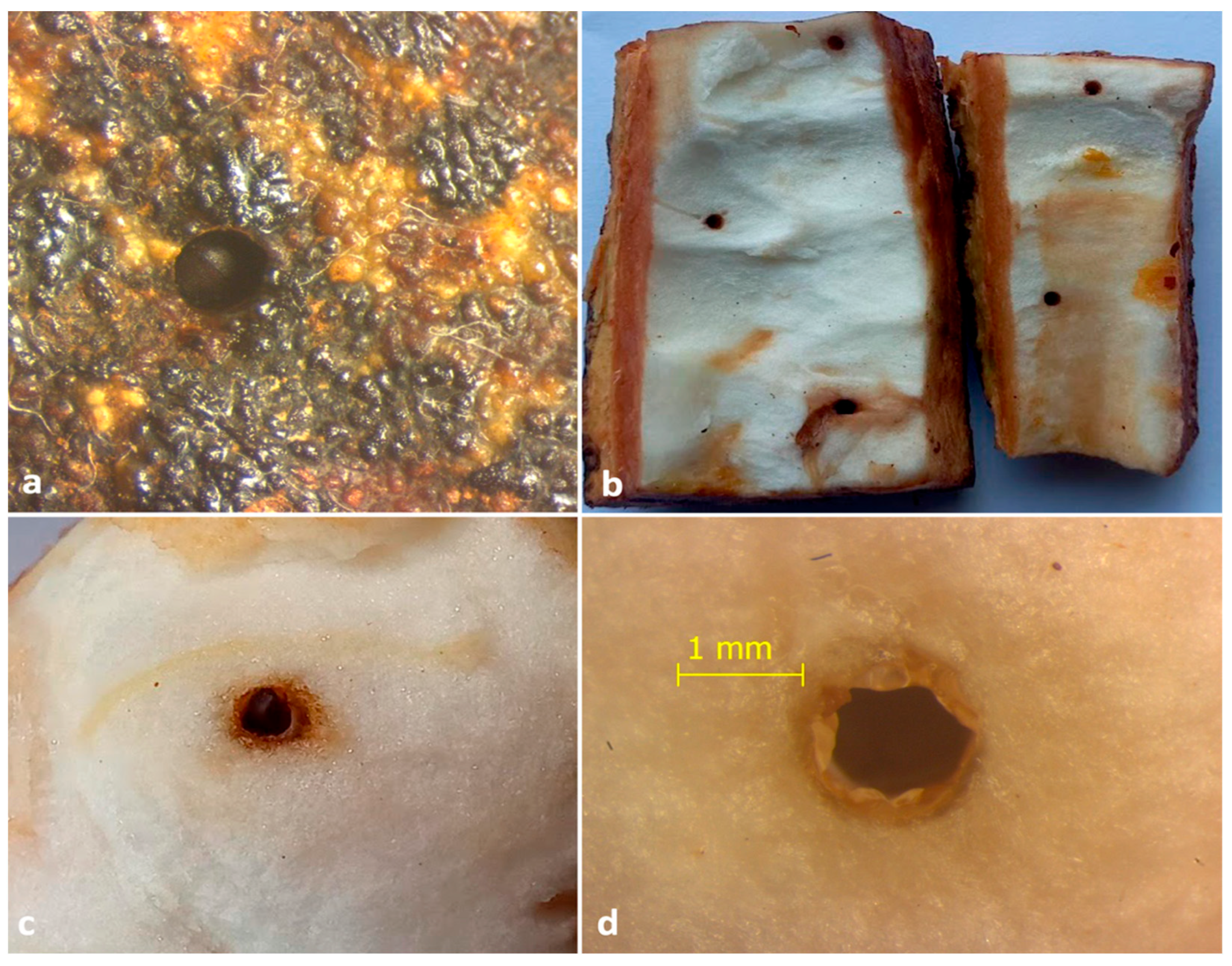
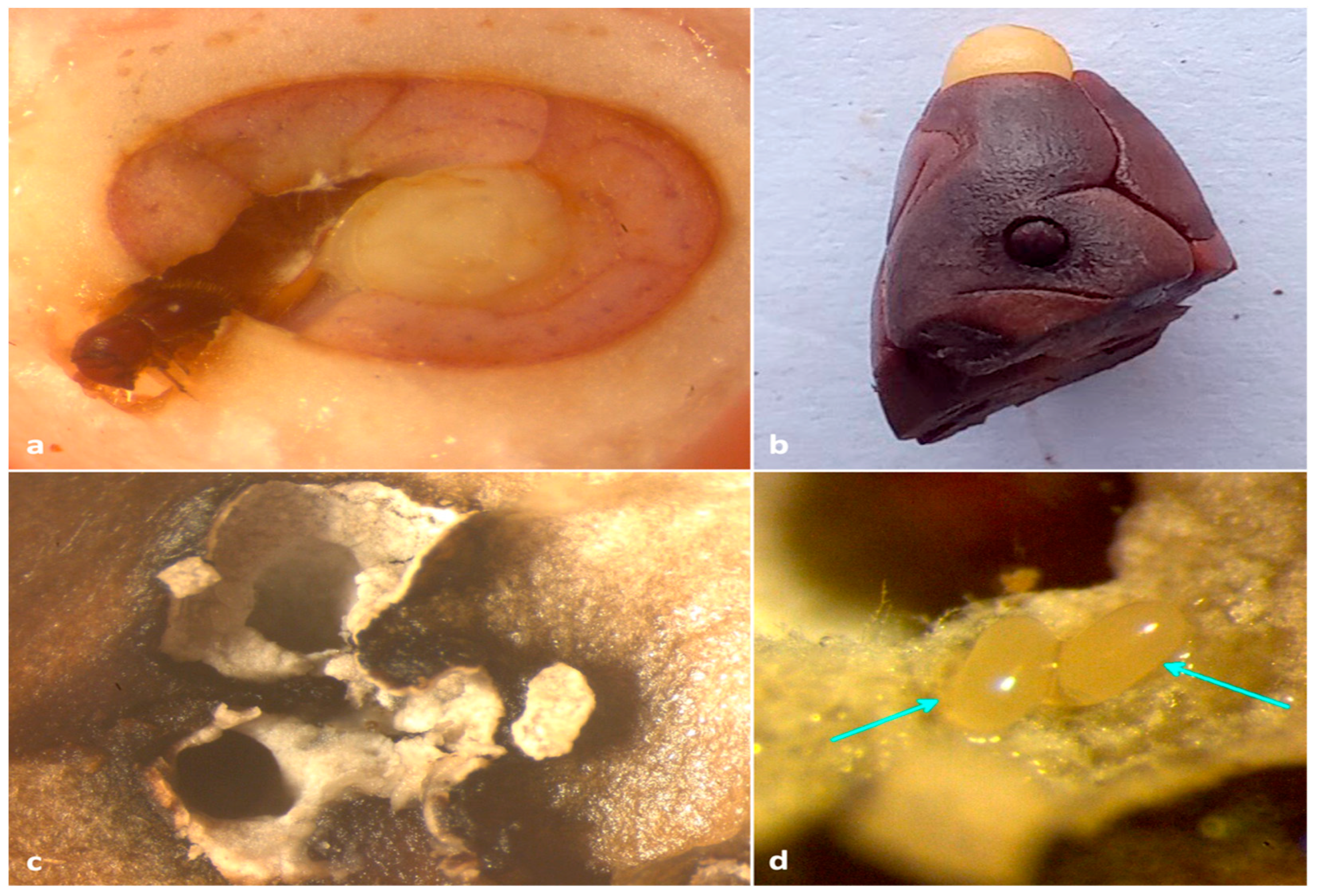
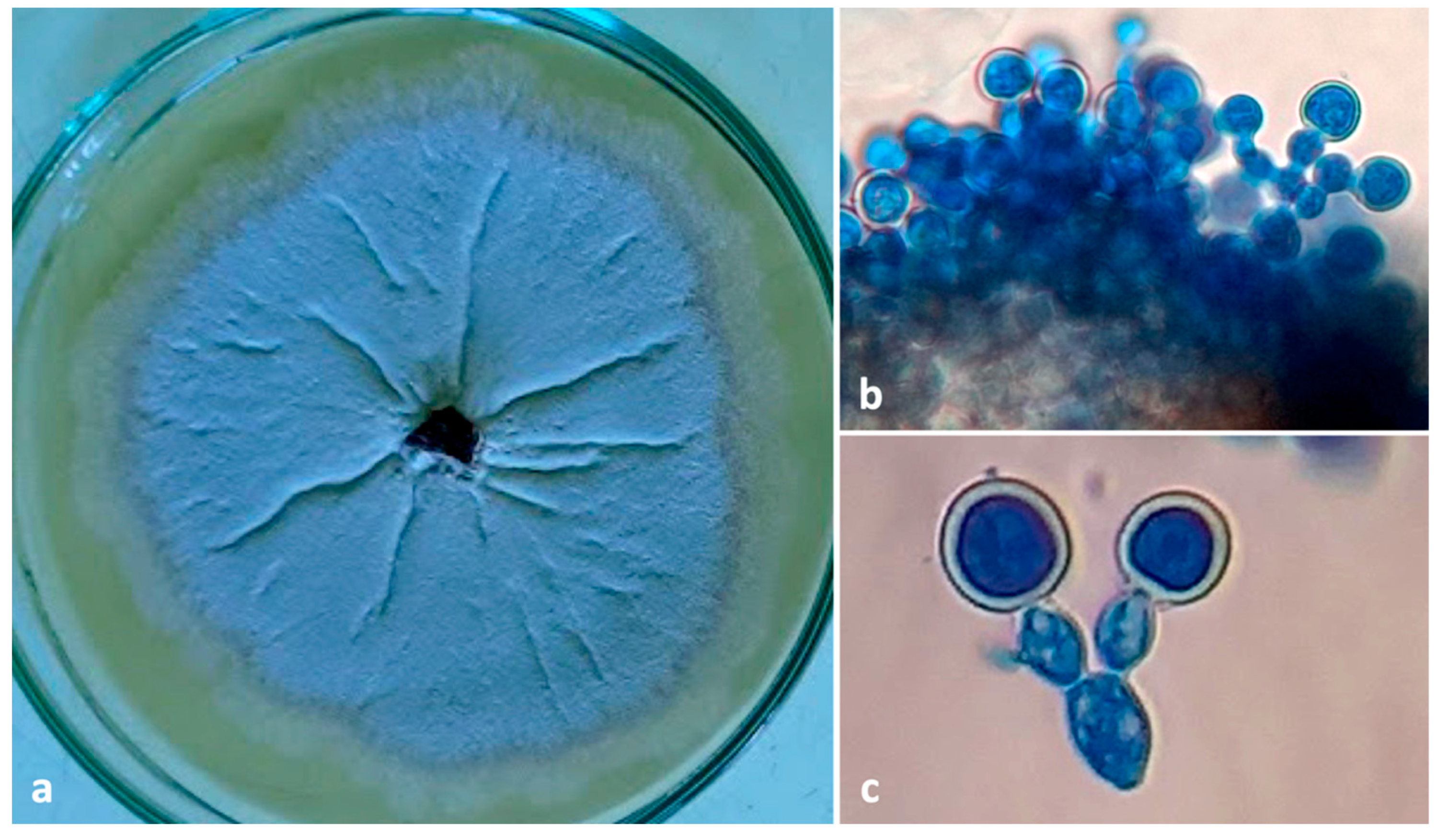
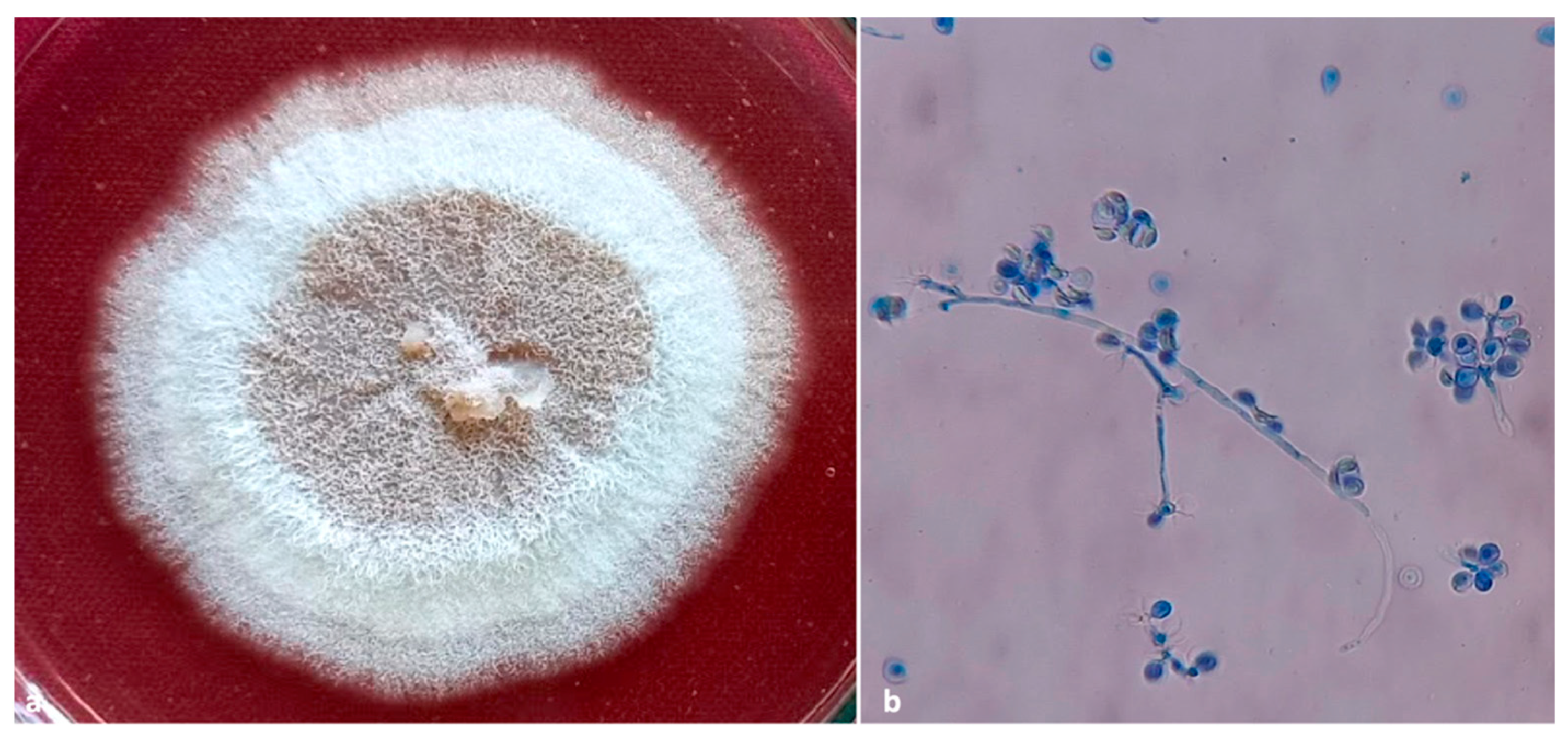
Publisher’s Note: MDPI stays neutral with regard to jurisdictional claims in published maps and institutional affiliations. |
© 2022 by the authors. Licensee MDPI, Basel, Switzerland. This article is an open access article distributed under the terms and conditions of the Creative Commons Attribution (CC BY) license (https://creativecommons.org/licenses/by/4.0/).
Share and Cite
Thube, S.H.; Pandian, R.T.P.; Josephrajkumar, A.; Bhavishya, A.; Nirmal Kumar, B.J.; Firake, D.M.; Shah, V.; Madhu, T.N.; Ruzzier, E. Xylosandrus crassiusculus (Motschulsky) on Cocoa Pods (Theobroma cacao L.): Matter of Bugs and Fungi. Insects 2022, 13, 809. https://doi.org/10.3390/insects13090809
Thube SH, Pandian RTP, Josephrajkumar A, Bhavishya A, Nirmal Kumar BJ, Firake DM, Shah V, Madhu TN, Ruzzier E. Xylosandrus crassiusculus (Motschulsky) on Cocoa Pods (Theobroma cacao L.): Matter of Bugs and Fungi. Insects. 2022; 13(9):809. https://doi.org/10.3390/insects13090809
Chicago/Turabian StyleThube, Shivaji Hausrao, R. Thava Prakasa Pandian, Arulappan Josephrajkumar, Anthara Bhavishya, B. J. Nirmal Kumar, Dnyaneshwar M. Firake, Vivek Shah, T. N. Madhu, and Enrico Ruzzier. 2022. "Xylosandrus crassiusculus (Motschulsky) on Cocoa Pods (Theobroma cacao L.): Matter of Bugs and Fungi" Insects 13, no. 9: 809. https://doi.org/10.3390/insects13090809
APA StyleThube, S. H., Pandian, R. T. P., Josephrajkumar, A., Bhavishya, A., Nirmal Kumar, B. J., Firake, D. M., Shah, V., Madhu, T. N., & Ruzzier, E. (2022). Xylosandrus crassiusculus (Motschulsky) on Cocoa Pods (Theobroma cacao L.): Matter of Bugs and Fungi. Insects, 13(9), 809. https://doi.org/10.3390/insects13090809







